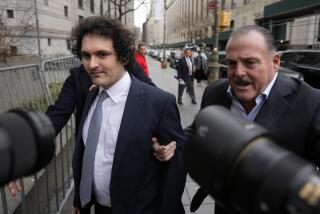Toxic assets become volatile
- Share via
WASHINGTON — Despite evidence that banks are regaining their health, the Treasury Department is pressing forward with a highly controversial program to help finance purchases of toxic assets that were at the heart of the nation’s plunge into economic chaos last year.
Treasury officials say the program is still needed because the assets -- complex securities on the balance sheets of banks that have virtually no market to trade in because they are so difficult to value -- still pose a threat.
“The outcry from those in need of loans is substantial,” said Lee Sachs, special advisor to Treasury Secretary Timothy F. Geithner. “We need to keep taking steps to help regenerate credit creation in this country.
But some outside critics say the government has moved so slowly to address the toxic assets that the problem is largely fixing itself and that the program’s design from the very beginning was so complex that it was bound to fail.
Indeed, President Obama said in a televised interview Tuesday that banks have recovered much more quickly than he expected. Investment bank giant Goldman Sachs & Co. posted a stunning $3.4-billion second-quarter profit Tuesday, and share prices of many banks have jumped in the last week.
The program to buy the toxic assets was unveiled by the Obama administration in March, describing it as a program of as much as $1 trillion to sop up mortgage-backed securities that were hobbling the banking system.
It was one of the administration’s biggest and riskiest efforts to bolster the financial sector at a time when securities markets were plunging. Since then, the outlook has brightened and the program has been sharply pared back to no more than $40 billion.
The program has since fallen about one month behind schedule and now may not be ready to start actual trading for at least another month, if not until fall.
Nine investment management firms were selected last week to partner with the Treasury Department, drawing $10 billion of direct investment from the government to match $10 billion they would raise from investors. The fundraising period will continue through early August. The firms could then obtain low-interest federal loans to leverage the funds up to a total of $40 billion.
Once organized, they would offer to buy the toxic securities from banks at less than full face value, but in theory, for more than the banks were being offered before.
But some critics say that the program never made much sense and that there is no need for it now.
“The program is an absolute failure,” said Mark Sunshine, president of Florida-based First Capital. “It is taking something complicated and making it more complicated.”
Sunshine, a securities attorney and longtime investment banker, disputed the original idea that no market existed for banks to sell the assets. The complex securities required lengthy due diligence to determine their value. As a result, specialists in distressed assets were offering rock-bottom spot prices to protect themselves from unknown risks.
On closer examination, the bundles of residential mortgages have significant value. The vast majority of mortgages underlying the securities are still performing, even as the real estate sector has tanked. And markets are increasingly trading those securities without any assistance from the Treasury Department as the price spread between buyers and sellers has narrowed.
Even so, senior Treasury officials say it would be a big mistake to back away from the program, because the government committed to it and the expectation has itself helped to restore credit markets in recent months.
“To say the programs are not needed is to ignore the many reasons why we came out with the program in the first place,” Sachs said.
Sachs said the effort, known as the Public Private Investment Partnership, was part of a complete package of efforts, including bank “stress tests,” direct funding to banks and other measures, to restore health to the banking system.
“They are all interrelated,” said Sachs, a former assistant Treasury secretary during the Clinton administration. “When we rolled out the program, we didn’t know which one would have the greatest uptake.”
But it is still uncertain whether many banks would be willing to sell the assets at depressed prices. Few, if any, have said they want to sell assets.
“We don’t have any plans to participate,” said Debora Vrana, a spokeswoman at City National Bank, a major Southern California institution that took money from the Treasury Department early in the Troubled Asset Relief Program despite its relatively strong financial condition.
Some critics add that the scaled-back program is now hardly big enough to help banks bolster their capital and provide the lending necessary for a healthy economic expansion.
“It is too small to make a difference,” said Simon Johnson, an economist with the MIT Sloan School of Management, adding that the failure of the program to restore banks’ health would ultimately slow the economic recovery.
--
More to Read
Inside the business of entertainment
The Wide Shot brings you news, analysis and insights on everything from streaming wars to production — and what it all means for the future.
You may occasionally receive promotional content from the Los Angeles Times.











